In the Homes of Sounds and Images...
Andrzej Czyżewski
Published in Pismo PG (Gdańsk University of Technology Magazine)
Planning this short article with the aim of presenting a brief history and today's shape of the Multimedia Systems Department, I recalled that "not so long" ago I published a very similar text in "Pisma PG" (a special monthly magazine for the employees and students of the Gdansk University of Technology). After a long search through my archives, I eventually found the copy. It dated back to January 1995! Astonished, I realized that it has already been 13 years since I wrote the article entitled "In the houses of sounds...", in which using a quotation from Francis Bacon's "New Atlantis" , I tried to demonstrate how the science of contemporary sound engineering solves problems that for centuries were greatest challenges faced by acoustics. For its real artistry, I quote again the original Bacon's text below.
"We have also sound-houses, where we practice and demonstrate all sounds and their generation. We have harmony which you have not, of quarter-sounds and lesser slides of sounds. Divers instruments of music likewise to you unknown, some sweeter than any you have; with bells and rings that are dainty and sweet. We represent small sounds as great and deep, likewise great sounds extenuate and sharp; we make divers tremblings and warblings of sounds, which in their original are entire. We represent and imitate all articulate sounds and letters, and the voices and notes of beasts and birds. We have certain helps which, set to the ear, do further the hearing greatly; we have also divers strange and artificial echoes, reflecting the voice many times, and, as it were, tossing it; and some that give back the voice louder than it came, some shriller and some deeper; yea, some rendering the voice, differing in the letters or articulate sound from that they receive. We have all means to convey sounds in trunks and pipes, in strange lines and distances."
Several years ago, that is in the time when the Department of Sound Engineering was mostly engaged in establishing scientific foundation for electroacoustics and phonic technologies, a four hundred years old Bacon's description of acoustic experiments seemed fascinating as it concerned conceptual and technological issues that have not found final solution till now. In this context, it was rather difficult to highly judge one's own scientific achievements while the inhabitants of mythical Atlantis could use musical instruments to produce sound of various quality; were able to analyze and process it, or even amplify whenever sounds were poorly audible. It is easy to notice that the text links different interdisciplinary fields of music acoustics with the hearing physiology and the analysis, processing and transmission of phonic signals. Thus, it concerns all those subjects to which our Department paid most attention in the research conducted till the year of 2000, and which we as a team constantly develop. The interest in music, that once fascinated the founders of the Department of Electrophony, has already been accompanying two generations of researchers and academic teachers, and we can say that it has developed into an abiding passion. Thus, at this point, I would like to present the 40 years long history of the Department.
History of the Multimedia Systems Department
| 1968 | - | The Department of Electrophony is called into existence as part of the Telecommunication Institute of the Faculty of Electronics. The main promoter of the Department's genesis was associate professor Marianna Sankiewicz. |
| 1982 | - | Associate professor Gustaw Budzyński becomes the Head of the Department, and at the same time the Department changes its name to the Department of Sound Engineering. Associate professor Budzyński headed the Department for 9 consecutive years, and during this time, he established and consequently developed the program of the first, and for a long time the only, specialty known in Poland as Sound Engineering. |
| 1985 | - | The Department of Sound Engineering organizes the Symposium on Sound and Vision Engineering and Mastering, during which the results of scientific research are presented. Since then, the Symposium becomes a regular scientific event organized by different Polish scientific centers and is held every second year. |
| 1991 | - | The Faculty of Electornics reorganizes. Associate professor Andrzej Czyżewski becomes the head of the Department. Thanks to the devoted and very effective work of all the researchers and other employees of the Department, the Audio Engineering Society grants its permission to establish the Polish Section. Only during the first two years of the Section's existence, some 150 persons successfully apply for membership of the Society. Other Polish universities begin to develop specialties concerning sound mastering. |
| 1994 | - | Doctoral Studies are founded at the Faculty of Electronics, Telecommunication and Informatics. The head of the Department becomes its director, and holds this position until 2007. |
| 1995 | - | The Faculty of Electronics changes its name to the Faculty of Electronics, Telecommunication and Informatics. |
| 1995 | - | Associate professor Marianna Sankiewicz becomes Vice-President of the international scientific Society of Audio Engineering. The Department establishes the Polish Students' Section of the Society. |
| 1997 | - | The Department gains more independence, and becomes an autonomous unit as it converts into the Department of Sound Engineering. |
| 2000 | - | As the scope of the Department's scientific research expands into new areas, its name changes to the Sound and Vision Engineering Department. |
| 2003 | - | Prof. Bożena Kostek is elected Vice-President of the Audio Engineering Society (which is to be repeated in 2007) |
| 2003 | - | The Head of the Department (prof. A. Czyżewski) is approved to the position of the full professor of GUT.The Department changes its name to the Multimedia Systems Department. |
Since approximately 2000, more intensively than before, we have been developing the research areas of vision recording and processing. The curriculum of our Department, as well as our research, now include issues related to the generation of audio and vision signals in a digital form. These issues are also connected with the signals recording, transmission, coding, and processing. We have put much attention to apply novel methods of artificial intelligence to audio and vision processing, particularly in the field of reducing noise and distortion in archive recordings, and in the transmission of speech in harsh conditions, such as those common in military aviation or taking place in the process of archive films reconstruction. These interests materialized in several practical implementations, and also in our taking part in a project of the UE 6. Framework Program, which has already been lasting four years.
The other areas that have also been within our special scientific involvement for recent 15 years are psychophysiology of hearing and vision, audiology, phoniatrics, and logopaedics. Nowadays, the electronic and information technologies gain more and more important role in the process of diagnosing and remedying the impairments of hearing. Among these technologies are audiometric measuring techniques and hearing prostheses in the form of hearing aids, and cochlear or core implants. Contemporary problems encountered in the medical treatment of auditory impairments or total deafness are certainly a great challenge for today's scientists who must rise to the task of finding more efficient methods of audio diagnosing and otolaryngological therapy. The solutions worked out in cooperation with the Warsaw Institute of Hearing Physiology and Pathology were the first interactive methods employed in a large scale screening tests of hearing, speech, and vision. The solutions we elaborated in this field got many nominations, and won numerous prestigious awards. A practical acknowledgement of our telemedicine applications usefulness and originality is that they were designated by the Polish Ministry of Education to be implemented in schools. Another implementation from the same field were the results of a long-time scientific research on the application of electronic methods to speech impediment correction carried out in the Department of Sound Engineering and Vision of the Technical University of Gdańsk in cooperation with several other Polish and international centers. A practical outcome of this research is an advanced method for the correction of stammering. The method uses a digital electronic device capable of performing a specific digital processing of speech signals through the use of an auditive acoustic feedback loop. Our latest achievement in this field is an original contactless hearing aid for newborn babies.
A meaningful breakthrough in the Department's development was our winning of several competitions held by the Foundation for Polish Science (FPS) which resulted in a prestigious Professor's Subsidy awarded to the Head of the Department, and allowed funding scientific scholarships for talented doctoral students. Winning subsequent FPS's competitions, this time concerning investments, let us build in 2003-2007 new laboratories and a seminar room constructed as a superstructure on the roof of the Faculty of Electronics, Telecommunication and Information building.
The World Exhibition of Innovation, Research and New Technology (Brussels Eureka 2003) awarded our solutions a gold medal and two Grand Prix prizes. The Department was also granted one of the three prestigious awards of the Chairman of the State Committee for Scientific Research in the "info" category. The implementations of the Department's research results (frequently accomplished in cooperation with other institutions) were often honored with various rewards, among which are the Prime Minister Award for the Scientific and Technical Achievements (2000), the nomination for the Economic Prize of the President of the Republic of Poland (2003), the gold medal of the International Trades in Poznan (2003), the nomination in the competition for the best European IST projects (eHealth Award, Ireland 2004) and many others. In 2007, the City of Gdańsk awarded the Jan Hevelius Prize for the Achievements in Scientific Research to prof. A. Czyżewski, the head of the Department.
Since Polish accession to the UE in 2004, a constantly growing number of various home and European institutions declare their will to cooperate with our research team. This generates new funds for scientific research, especially those aimed at practical implementations. Many multimedia systems applications that we have already implemented cause new projects to be launched and induce a rapid expansion of the team. The current research and development program of the Department includes the following projects realized till 2004 or planned for 2006-2010. Customarily, we use acronyms of these projects within the team and in such a convention I present their list below.
1. INFOPILOT - A system that records speech, improves its quality and realizes transmission between ground stations and military aircraft pilots. Implemented in 2005 in a Polish military pilots training school of Deblin.
2. DESYME - An international project completed in 2007, that enables a self-reliant design and programming of various cellular phone services (formerly exclusively reserved for cellular-phone network operators).
3. SDSA - A project, whose aim was to miniaturize the speech prosthesis (once invented and developed in the Gdansk University of Technology) dedicated for stuttering persons. In June 2007 Mr. Peter Odya successfully defended his Ph.D. dissertation on the subject. The results of the project were implemented in a form of a high-tech product by "Platan", a Polish company located in Sopot. The project was partially subsidized by a dedicated grant provided by the Chief Technical Organization of Scientific and Technical Associations.
4. LARYNX - An original concept of the artificial larynx for persons after laryngectomy, i.e. after the larynx amputation. A digital larynx and a miniaturized synthesizer was designed and produced in cooperation with "Intech", a company from Gdansk. The project was subsidized by a dedicated grant from the Chief Technical Organization Federation of Scientific and Technical Associations. Now, "Intech" starts serial production of the larynx prosthesis licensed by the Gdansk University of Technology.
5. PRESTOSPACE - An integrated project of the 6. Framework Program being realized in cooperation with such corporations as BBC or RAI. The Gdansk University of Technology is responsible for developing tools for the reconstruction of archive materials (old recordings and films). European archives repositories store nearly 200 millions of audio-visual material, part of which could be prevented from further depreciation through the use of these tools.
6. VoIP - A project dedicated to the invention and development of more effective speech coders intended for the Internet telephony. The project will be implemented by "Wirtualna Polska" in its web portal. The project is subsidized by a grant from Polish Ministry of Science and Higher Education.
7. APARATY_SŁUCHOWE - A project dedicated to special hearing aids. The invention of a non-invasive hearing prosthesis for newborn babies was declared the most interesting acoustic technology of the greatest sound engineering forum held in San Francisco in 2006. Doctoral students involved in implementing the prosthesis were honored with a symbolic gift (a fountain pen) by President of Poland in the Presidential Palace (2006). The project was financed by the Polish Ministry of Science and Higher Education with a research grant.
8. NOISE - The project aim is to elaborate teleinformatic tools capable of monitoring noise and road traffic in agglomerations. The concept of this project was used by the City Council of Gdansk. Independently, the Gdansk University of Technology signed a license agreement with DGT company concerning the implementation of intelligent wireless monitoring stations in other cities. The project is co-funded by the Ministry of Science and Higher Education as an R&D grant.
9. SECURITY - The project is supported by the Polish Internal Security Platform. Its results will allow to monitor the degree of security in stadiums, schools and other places threatened with acts of terror. The idea of the project is to design and develop teleinformatic tools that would supplement the functions of already existing audio and video monitoring systems. The extension will be a function of automatic image and sound interpretation, which will let computer systems automatically discover potential threats and generate alerts to appropriate services responsible for public order and security. The project is co-funded by the Ministry of Science and Higher Education as an R&D grant.
10. INDECT - The continuation and extension of the SECURITY project. The project is a Europe-wide venture, which will be realized in cooperation of Polish, German and European Police, and many prominent Polish and European technical universities. The Gdansk University of Technology is the initiator and main contributor to the project. The project was approved by the European Commission, who is its founder, in September 2007, and has the budget of several million Euro. SECURITY is the first integrated European project from the domain of security technologies, prepared an coordinated in Poland.
11. PERFORM - An integrated high-budgeted European project from the domain of telemedicine, coordinated by Siemens. The Multimedia Systems Department is responsible for developing teleinformatic equipment designed for the remote monitoring of the patients that suffer from neurodegenerative diseases (mainly Parkinson). The project is funded by the European Commission and has the budget of ca. 7 million Euro.
12. KEY_IPIPAN - One of the three planned, nation-wide key projects from the domain of informatics, preliminary accepted to be funded by European Structural Funds. The Gdansk University of Technology, as one of the main contributors to the project, joined the consortium coordinated by the Institute of Computer Science (Polish Academy of Sciences) and is responsible for implementing intelligent computational methods used to computerize broadcasting in the field of telemedicine. The Multimedia Systems Department working on behalf of the Gdansk University of Technology is one of the project participants.
13. MULTIMODAL - A dedicated project co-funded by the Ministry of Science and Higher Education. Its realization is now starting in cooperation with Young Digital Planet S. A (YDP), a Polish company. The aim of the project is to elaborate and implement novel methods of man-computer communication (interacting with a user through other means than a traditional mouse and keyboard) in the YDP's products. The computer will be able to contact with the user in several ways -- through tracking eye movement and visual attention, through an "intelligent ball pen" in the cases were dyslexia therapy is necessary, or through tracking lips movement as a help for people with paralyzed hands.
14. KEY_KSMPG - The second of the key projects from the domain of informatics, accepted by the Council of Ministers. This time the Multimedia Systems Department is the coordinator and the contractor of the project. The objectives of the project extend the multimodal interfaces issues.
15. NOWE_MEDIA - A subproject within the framework of the National Foresight Project „Polska 2020", in which the Multimedia Systems Department is responsible for the concepts of future development of the media in our country.
I allowed myself to mention all the newest projects in the belief that their subjects most illustratively indicate the directions of our scientific interests and competence, and in consequence influence the Department's curriculum. When asked about the Multimedia Systems Department development plans, I usually answer that they are closely related to the effects of the above mentioned projects. Some of the ventures have the duration of 5 years. However, the teleinformatic technologies evolve so quickly now, that currently made plans may turn out to be fallible. We all believe that such scientific discipline as sound and vision engineering will astonish us with its unpredicted capabilities of quick progress... Anyway, the Department will welcome everyone interested in studying our discipline, or in cooperating with us as a scientist or practical implementer to our common "house of sounds and images".
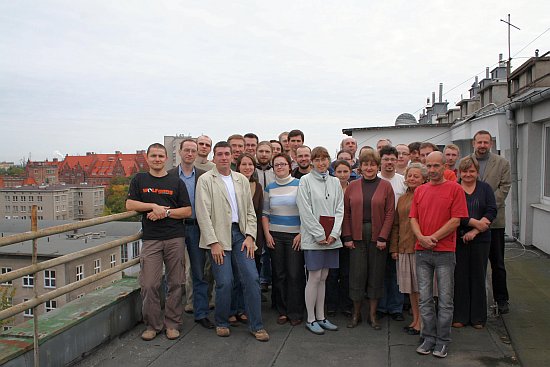
The Department's Staff (in 2007)
See large version
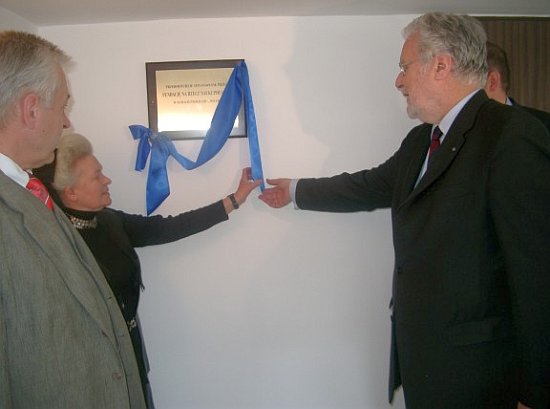
Prof. Janusz Rachoń the Rector of the Gdansk University of Technology, Associate professor Marianna Sankiewicz, and Prof. Maciej Grabski President of the Foundation for Polish Science (FPS), when unveiling the foundation plaque of the new laboratories and a seminar room financed by means of the award granted to the Department for winning the PFS's competition in 2004.
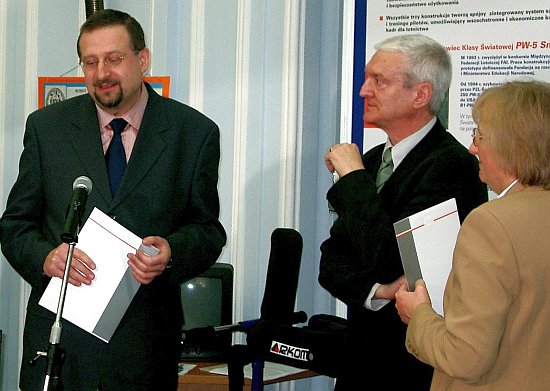
The head of the Multimedia Systems Department, prof. Andrzej Czyżewski, when expressing his and the whole Department's gratitude for the award of the Chairman's of State Committee for Scientific Research granted in the category of "info" by prof. M. Kleiber upon the completion of the Committee's activity in 2004.
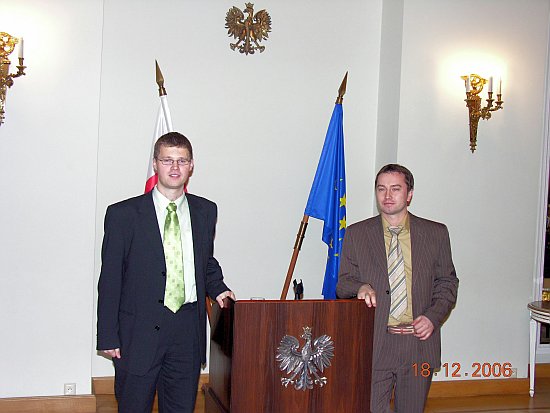
The Multimedia Systems Department doctoral students – Maciej Kulesza and Paweł Żwan, after being honored with a symbolic gift (a fountain pen) by President of Poland Lech Kaczynski in the Presidential Palace during the celebration of „My Talent for Poland" (2006)
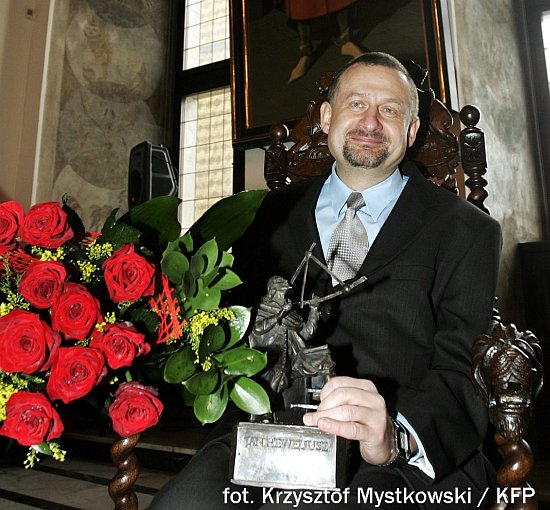
The head of the MSD, prof. Andrzej Czyżewski, when receiving John Hevelius Scientific Award of the City of Gdansk for his own and the Department's stuff achievements.